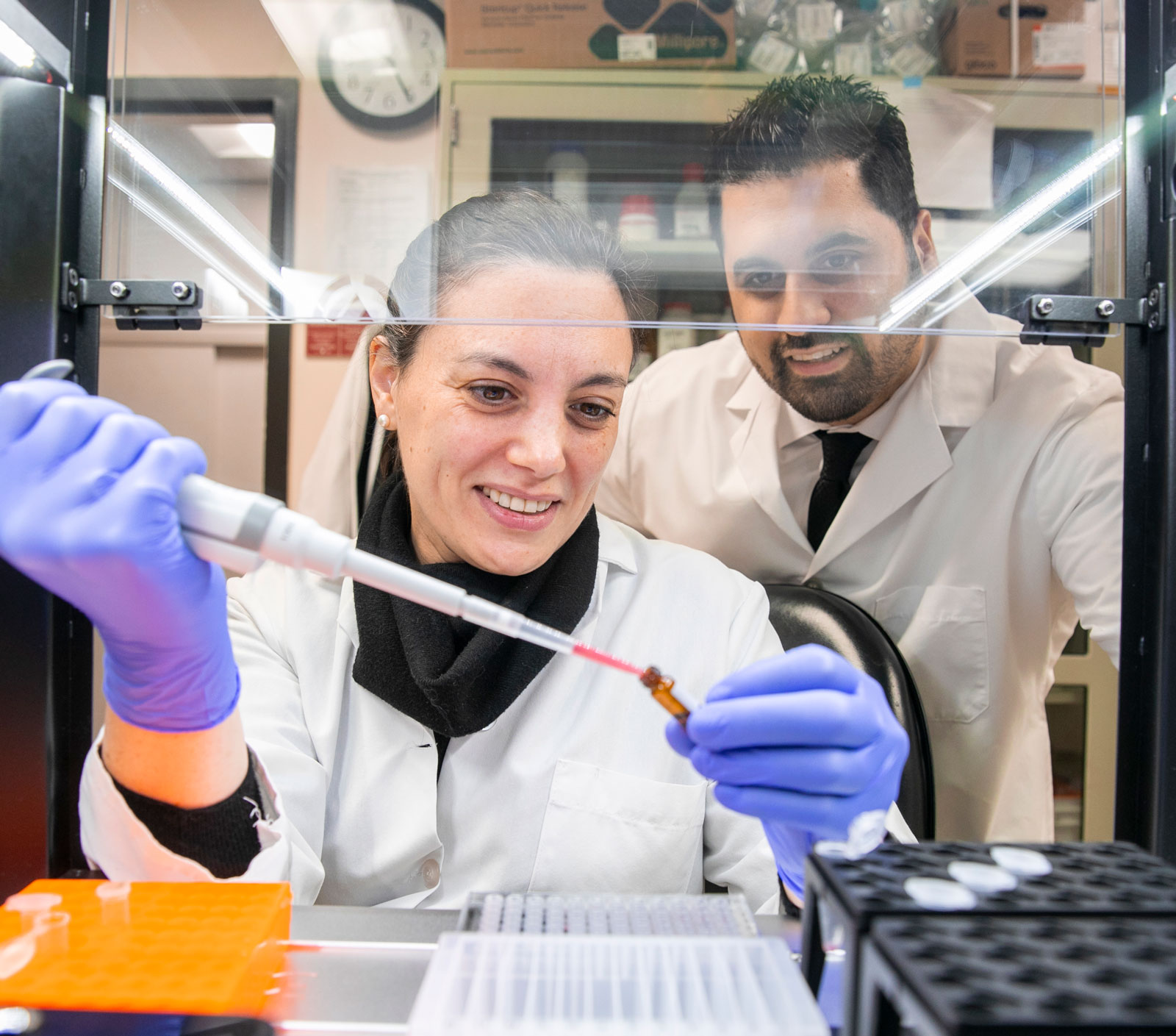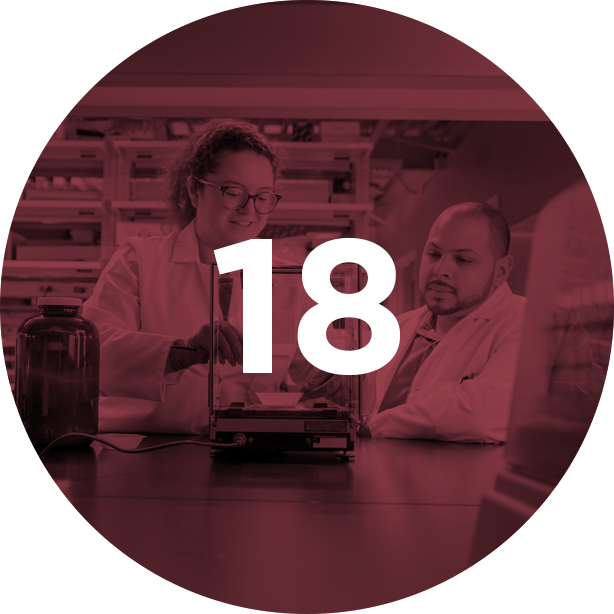
Graduate School of Biomedical Sciences
We train inquisitive and determined scientists looking to pursue careers in biomedical research, management, academia and health care. If you’re looking for a post-baccalaureate (post-bac) or a professional health program, we can help you develop your academic credentials to get there.

The GSBMS is home to exciting research advances across the biomedical sciences. Our M.S. and Ph.D. programs allow you to specialize and follow your scientific journey wherever you choose. Become a clinical laboratory scientist, a research manager at a pharmaceutical firm, or a research professor—whatever your scientific aspiration, we can put you on that path.
Programs Tailored to Your Goals and Interests
Whether your aim is to start working as a clinical laboratory scientist as soon as possible, enter an intensive Ph.D. program or build up your academic credentials before medical school, we have something for every biomedical science student. All our programs meet specific educational goals.
Discipline-Based Programs
Professional Science Master’s (PSM)
Each of the six discipline-specific M.S. programs also offers a Biomedical Science & Management - Professional Science Master’s (PSM) track for those interested in pursuing careers in the pharmaceutical, biotechnology, or other biomedical science industries, as well as government and not-for-profit sectors related to these fields.
Pre-Professional Programs
Accelerated Interdisciplinary Biomedical Sciences Master’s Program
A one year master's program for aspiring medical students.
Interdisciplinary Biomedical Sciences Master’s Program
A two year master’s program for aspiring scientists, dentists, physicians, veterinarians, etc.
Clinical Laboratory Studies Master's Program
This master’s degree will prepare you for CLS licensure and work in a clinical laboratory.
Dental Linker Program
A one year accelerated master's program for aspiring Touro College of Dental Medicine students. By referral only from the TCDM Admissions Committee.
Why GSBMS is a Great Place for Aspiring Scientists

- Small class size and hands-on mentorship and research training.
- Interdisciplinary learning environment in partnership with the NYMC School of Medicine.
- Extensive opportunities for both research and professional-focused careers.
- More than $30 Million in external annual funding for biomedical research.
- Opportunities for real-world lab experience in every program.
Quick Facts

18 academic programs across the biomedical sciences.

>85% student acceptance rate to medical school programs from our post-bac programs.

More than $1 million in scholarships annually to M.S. and Ph.D. students.

10 hospital affiliates in NY & CT, providing training for our clinical laboratory sciences students.
Recent GSBMS News
Janice Fung’s Quest to Combat Plague Through Vaccine Innovation
GSBMS Student Investigates Mucosal Vaccines Against Yersinia Pestis
NYMC Launches Illuminating Discovery Symposium Series on Biomedical Imaging
The annual event underscores the potential for innovative projects and strategic partnerships in bioimaging.
Adiya Katseff’s Scientific Pursuit of Immunological Defense
GSBMS Student Pioneers New Vaccine Technologies to Combat Antibiotic-Resistant Infections
HeLa Conference Highlights Solutions to Health Equity
Presenters Explore the Path to Inclusive Health Care and the Real-World Impact
Upcoming GSBMS Events
Apr 2Wednesday, April 2, 2025, 1 - 2pm ETPMI Grand Rounds - Karen Seiter, M.D.
Graduate School of Biomedical Sciences
Apr 3Thursday, April 3, 2025, 11am - 3pm ETOneonta Healthcare Professional School Expo
Graduate School of Biomedical Sciences
Apr 7Monday, April 7, 2025, 4 - 6pm ETFordham University Health Professions Fair
Graduate School of Biomedical Sciences
Apr 9Wednesday, April 9, 2025, 12 - 4pm ETBinghamton University Charles Drew Pre-Health Society Graduate Schools Fair
Graduate School of Biomedical Sciences
What Sets GSBMS Apart
[AUDIO DESCRIPTION] Logo: New York Medical College, A Member of Touro University, School of Health Sciences and Practice
A sign hangs above the entrance of a multi-storied brick building: School of Health Sciences and Practice
[MUSIC PLAYING]
[AUDIO DESCRIPTION] Robert W. Amler, M.D., M.B.A. Vice President for Government Affairs, Dean; Professor, Public Health, School of Health Sciences & Practice; Professor, Pediatrics, School of Medicine
[Robert Amler] At the School of Health Sciences and practice at New York Medical College, we train our graduate students in the public health disciplines and in the rehabilitative therapies, like physical therapy, speech language pathology, and a focus on pediatric swallowing disorders in a beautiful campus location just a short drive North of New York City.
[MUSIC PLAYING]
[AUDIO DESCRIPTION] Ainsley Rossi, D.P.T., PT, OCS Assistant Professor, Physical Therapy, School of Health Sciences & Practice
[Ainsley Rossi] Being here in Westchester County, we have all of the resources available to a huge city with a really lovely, cozy campus feel.
[MUSIC PLAYING]
[AUDIO DESCRIPTION] Malik, Class of 2026, School of Health Sciences & Practice
[Malik] I love the Westchester location. The greenery is really nice.
[Ainsley Rossi] And it is a microcosm of society, all different walks of life, different cultural backgrounds. It's just a really dynamic place to be.
[AUDIO DESCRIPTION] A video images show students talking as they stroll outside on campus. Fluted columns stand at the entrance of a brick building.
[MUSIC PLAYING]
[AUDIO DESCRIPTION] Stefanie Blanco, SLP.D., CCC-SLP, TSSLD, ATP Assistant Professor and Director of Clinical Education, Speech-Language Pathology, School of Health Sciences & Practice
[Stefanie Blanco] New York Medical College has really dedicated, intelligent, compassionate faculty that work very closely with the students. We have over 150 clinical affiliation sites, so students are able to go into schools, into outpatient clinics, into a hospital's acute care, inpatient, outpatient rehab centers. So they get a variety of experiences.
[AUDIO DESCRIPTION] Angela plays a card game with a student in a classroom.
[MUSIC PLAYING]
[AUDIO DESCRIPTION] Angela, Class of 2025, School of Health Sciences & Practice
[Angela] Right now, I'm in my medical rotation, which allows me to work at skilled nursing facilities, children's hospitals, and Westchester Medical Center.
[AUDIO DESCRIPTION] Sign: Westchester Medical Center, University Hospital
[MUSIC PLAYING]
[AUDIO DESCRIPTION] Vikas Grover, Ph.D., CCC-SLP -- Chair, Department of Rehabilitation Sciences; Division Chief; Academic Program Director; Professor Speech-Language Pathology, School of Health Sciences & Practice
[Vikas Grover] We start our students with the clinical education from day one. Many schools do not.
[Stefanie Blanco] For the Masters of Speech Language Pathology program, the students are participating in both academic and clinical rotations.
[AUDIO DESCRIPTION] A student holds up a flash card for a boy who sits with a mirror in front of him.
[Stefanie Blanco] In students' first semester, they're going to be in our in-house clinic, and they're going to be treating and evaluating pediatric speech language clients.
[Vikas Grover] We start day one because we want them to be feeling and understanding the real world from the very beginning. And also when they are taking their foundational courses, they are actually seeing things happening in the clinic at the same time.
[Angela] So you're able to bridge that what you're learning in the classroom to what you're seeing in the clinic beginning your first couple of weeks.
[AUDIO DESCRIPTION] Malik holds his hands on a patient's knee in a clinical setting.
[Malik] I really liked how it went from in-class work to clinical application right afterwards, because it forced me to look at the coursework from the classroom in a different lens. For my first of four clinical rotations, I was at an inpatient facility. The best part was seeing, again, that direct carryover from what I learned in the class two months ago to being able to do those exact same things inside an inpatient facility. You are experiencing it. You are doing it, so it's kind of ingrained in your memory.
[Ainsley Rossi] Because we are also a medical school, we have access to a lot of the facilities that you may not get in other institutions. So our PT students, instead of just observing a virtual anatomy dissection, actually participate in dissections and get to do their anatomy studies in a cadaver lab.
[AUDIO DESCRIPTION] Photos show students in the anatomy lab.
[Malik] Our anatomy class is taught by medical faculty. I love the fact that I, as a physical therapy student, have 24/7 access to the cadaver lab.
[Ainsley Rossi] All of the faculty are incredibly accomplished and very caring, and they know their students. We also are committed to updating facilities regularly, so there's a lot of new equipment that is always coming through.
[Angela] As an SLP student, I really like how I'm able to collaborate with both public health students and with physical therapy students. New York Medical College does a great job with connecting different disciplines. So with physical therapy, speech, public health, we're all working together.
[MUSIC PLAYING]
[AUDIO DESCRIPTION] Kenneth A. Knapp, Ph.D. Chair and Assistant Professor, Public Health; Director, Dr. P.H. Program, Public Health, School of Health Sciences & Practice
[Kenneth Knapp] Many of our public health students work in the health care sector already. One of the reasons they like us and they come to us is because of the considerable flexibility that we offer. We
[AUDIO DESCRIPTION] An instructor speaks at the front of a classroom with a large screen on the wall behind her. Then a student works at a laptop.
[Kenneth Knapp] We have classes that begin later in the day. We have a variety of learning formats. We have asynchronous online.
[MUSIC PLAYING]
[AUDIO DESCRIPTION] Bruno, Class of 2025, School of Health Sciences & Practice
[Bruno] The experience has been phenomenal. The faculty are really supportive and there for us. The classes are small.
[AUDIO DESCRIPTION] An image shows about 8 students gathered around a table.
[Kenneth Knapp] We offer Master of Public Health programs. We also offer a rigorous Doctor of Public Health program, and we have Master of Science degrees in epidemiology and biostatistics.
[Bruno] I am in the doctoral program in health policy and management. It's giving me more knowledge and the ability to apply it directly into real life.
[Robert Amler] We prepare our graduates for their future roles as competent physical therapists, as insightful speech language pathologists, experts in disaster preparedness and response, global health, all of the different public health specialties. In every one of these programs, we find our way to tie what you see in the exam room, to what you see in the classroom and what you see in your community.
[MUSIC PLAYING]
[AUDIO DESCRIPTION] Edward C. Halperin, M.D., M.A. -- Chancellor and Chief Executive Officer; Professor, Radiation Medicine and Pediatrics, School of Medicine
[Edward Halperin] We are doing great things at New York Medical College. Great things are happening here. We have an honorable past, a strong and vibrant present, and the future is promising.
[MUSIC PLAYING]
[AUDIO DESCRIPTION] Students in caps and gowns smile at a commencement ceremony.
Logo: New York Medical College, A Member of Touro University, School of Health Sciences and Practice
[MUSIC FADES]
NYMC laboratories have a long history of producing high-growth reassortant seed viruses for the influenza vaccine, ultimately used to produce 400 to 500 million doses of flu vaccine annually.
The NYMC Genomics Core Laboratory in the Department of Pathology, Microbiology and Immunology was selected to assist New York State in the identification of COVID-19 variants. Data is be used and helps build an understanding of disease manifestations, therapy or vaccine evasion and efficacy, and will support other discoveries to inform public health intervention.

